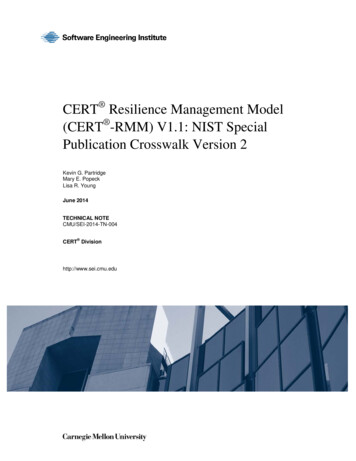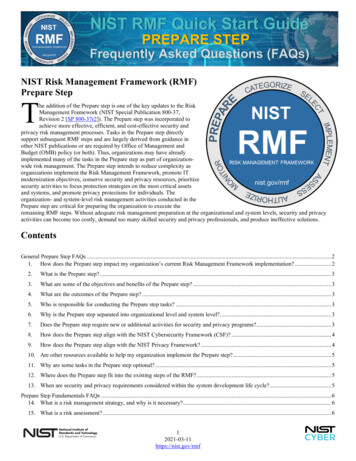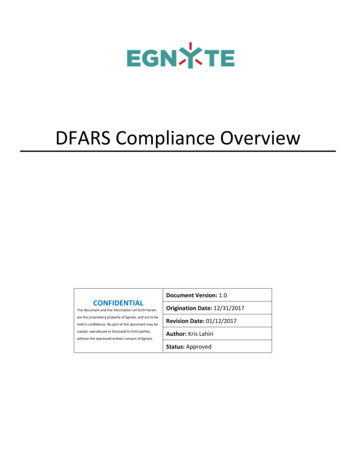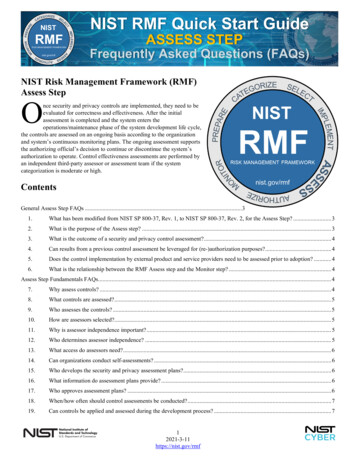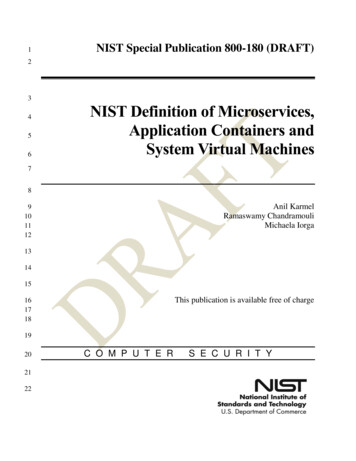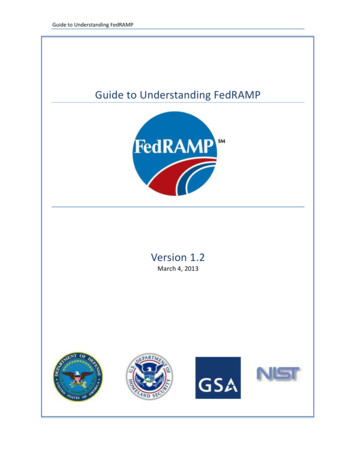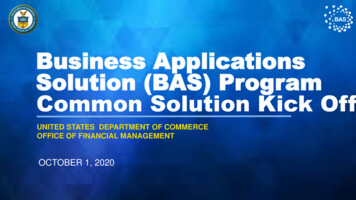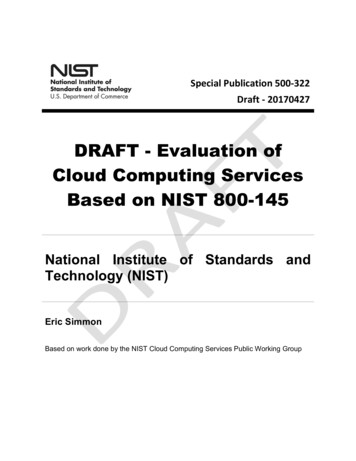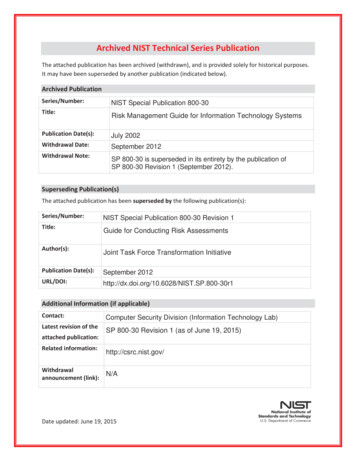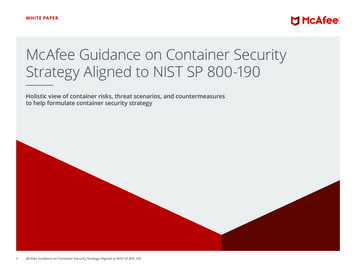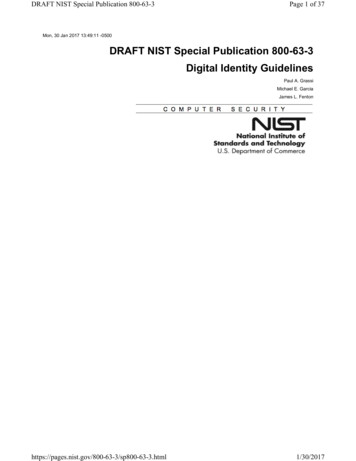
Transcription
DRAFT NIST Special Publication 800-63-3Page 1 of 37Mon, 30 Jan 2017 13:49:11 -0500DRAFT NIST Special Publication 800-63-3Digital Identity GuidelinesPaul A. GrassiMichael E. GarciaJames L. tml1/30/2017
DRAFT NIST Special Publication 800-63-3Page 2 of 37DRAFT NIST Special Publication 800-63-3Digital Identity GuidelinesPaul A. GrassiMichael E. GarciaApplied Cybersecurity DivisionInformation Technology LaboratoryJames L. FentonAltmode NetworksLos Altos, CAMonth TBD 2017National Institute of Standards and TechnologyKent Rochford, Acting Under Secretary of Commerce for Standards and Technology and .html1/30/2017
DRAFT NIST Special Publication 800-63-3Page 3 of 37AuthorityThis publication has been developed by NIST in accordance with its statutory responsibilities under the Federal Information SecurityModernization Act (FISMA) of 2014, 44 U.S.C. § 3541 et seq., Public Law (P.L.) 113-283. NIST is responsible for developinginformation security standards and guidelines, including minimum requirements for federal systems, but such standards andguidelines shall not apply to national security systems without the express approval of appropriate federal officials exercising policyauthority over such systems. This guideline is consistent with the requirements of the Office of Management and Budget (OMB)Circular A-130.Nothing in this publication should be taken to contradict the standards and guidelines made mandatory and binding on Federalagencies by the Secretary of Commerce under statutory authority. Nor should these guidelines be interpreted as altering orsuperseding the existing authorities of the Secretary of Commerce, Director of the OMB, or any other Federal official. Thispublication may be used by nongovernmental organizations on a voluntary basis and is not subject to copyright in the United States.Attribution would, however, be appreciated by NIST.National Institute of Standards and Technology Special Publication 800-63-3Natl. Inst. Stand. Technol. Spec. Publ. 800-63-3, xxx pages (MonthTBD 2017)CODEN: NSPUE2Certain commercial entities, equipment, or materials may be identified in this document in order to describe anexperimental procedure or concept adequately. Such identification is not intended to imply recommendation orendorsement by NIST, nor is it intended to imply that the entities, materials, or equipment are necessarily the bestavailable for the purpose.There may be references in this publication to other publications currently under development by NIST inaccordance with its assigned statutory responsibilities. The information in this publication, including concepts andmethodologies, may be used by federal agencies even before the completion of such companion publications.Thus, until each publication is completed, current requirements, guidelines, and procedures, where they exist,remain operative. For planning and transition purposes, federal agencies may wish to closely follow thedevelopment of these new publications by NIST.Organizations are encouraged to review all draft publications during public comment periods and provide feedbackto NIST. Many NIST cybersecurity publications, other than the ones noted above, are available athttp://csrc.nist.gov/publications (http://csrc.nist.gov/publications).Reports on Computer Systems TechnologyThe Information Technology Laboratory (ITL) at the National Institute of Standards and Technology (NIST) promotes the U.S.economy and public welfare by providing technical leadership for the Nation’s measurement and standards infrastructure. ITLdevelops tests, test methods, reference data, proof of concept implementations, and technical analyses to advance the developmentand productive use of information technology. ITL’s responsibilities include the development of management, administrative,technical, and physical standards and guidelines for the cost-effective security and privacy of other than national security-relatedinformation in Federal systems. The Special Publication 800-series reports on ITL’s research, guidelines, and outreach efforts insystem security, and its collaborative activities with industry, government, and academic organizations.AbstractThese guidelines provide technical requirements for Federal agencies implementing digital identity services and are not intended toconstrain the development or use of standards outside of this purpose. The guidelines cover remote authentication of users (such asemployees, contractors, or private individuals) interacting with government IT systems over open networks. They define technicalrequirements in each of the areas of identity proofing, registration, authenticators, management processes, authentication protocolsand related assertions. This publication supersedes NIST SP 800-63-1 and SP 3.html1/30/2017
DRAFT NIST Special Publication 800-63-3Page 4 of 37Keywordsauthentication; authentication assurance; authenticator; assertions; credential service provider; digital authentication; digitalcredentials; identity proofing; passwords; PKI.AcknowledgementsThe authors gratefully acknowledge Kaitlin Boeckl for her artistic graphics contributions to all documents in the SP 800-63-3 suite.In addition, the authors would like to acknowledge the thought leadership and innovation of the original authors: Donna F. Dodson,Elaine M. Newton, Ray A. Perlner, W. Timothy Polk, Sarbari Gupta, and Emad A. Nabbus. Without their tireless efforts, we would nothave had the incredible baseline from which to evolve 800-63 to the document it is today.AudienceCompliance with NIST Standards and GuidelinesConformance TestingNote to ReviewersThe Special Publication 800-63-3 suite is a significant update from past revisions. We encourage a careful and thoughtful review theentire document set; however the following list details the most impactful updates to how agencies accept digital identities or deploydigital identity systems.1. Levels of Assurance (LOA) is decoupled into individual parts for agencies to select. SP 800-63-3 provides guidance on how anagency can accomplish individual assurance level selection based on mission and risk. The other documents in the suite detailthe requirements for each of the relevant assurance levels.2. Identity proofing, both remote and in-person, has been completely rewritten, adding many new requirements not present in pastversions.3. Insecure authenticators have been removed, specifically pre-registered knowledge tokens and out-of-band (OOB) one-timepasswords (OTP) sent to email.4. Added new requirements for OOB OTP sent via SMS and VOIP. NIST’s position remains the same: agencies should be carefulabout the use of SMS as it does not always prove possesion of something you have, and therefore may not be an appropriatesecond factor. We removed the term ‘deprecated’ due to our experience of stakeholders misinterpreting this term to mean ‘nolonger allowed’. This was not our intent. Rather, we want to signal to agencies that SMS is under serious consideration forremoval in future versions. This public draft avoids the term deprecation for which uses differ in differing contexts, but theupshot of the guideline is unchanged.5. Modernized password requirements and applied these requirements consistently across all assurance levels.6. Expanded options for use of biometrics while including new requirements when biometrics are used.7. Introduced new authenticators allowable at the highest assurance levels.8. Added requirements for Verifier Compromise Resistance (i.e., is my secret safe?) and Authentication Intent (i.e., it really wasme, not malware, attempting to authenticate)9. Modernized federated assertions, removed cookies as an allowable assertion type, and increased security requirements forassertions.10. Added privacy requirements and usability considerations to all assurance levels.We look forward to your comments and feedback regarding the above, as well as any other areas that may need improvement orchanges. Our priority remains to offer agencies as many options and techniques as possible to manage risk and offer valuable digitalservices.Requirements Notation and ConventionsThe terms “SHALL” and “SHALL NOT” indicate requirements to be followed strictly in order to conform to the publication and fromwhich no deviation is -3.html1/30/2017
DRAFT NIST Special Publication 800-63-3Page 5 of 37The terms “SHOULD” and “SHOULD NOT” indicate that among several possibilities one is recommended as particularly suitable,without mentioning or excluding others, or that a certain course of action is preferred but not necessarily required, or that (in thenegative form) a certain possibility or course of action is discouraged but not prohibited.The terms “MAY” and “NEED NOT” indicate a course of action permissible within the limits of the publication.The terms “CAN” and “CANNOT” indicate a possibility and capability, whether material, physical or causal or, in the negative, theabsence of that possibility or 3-3.html1/30/2017
DRAFT NIST Special Publication 800-63-3Page 6 of 37Executive SummaryDigital identity is the online persona of a subject, and a single definition is widely debated internationally. The term persona isapropos as a subject can represent themselves online in many ways. An individual may have a digital identity for email, and anotherone for personal finances. A personal laptop can be someone’s streaming music server yet also be a worker-bot in a distributednetwork of computers performing complex genome calculations. Without context, it is difficult to land on a single definition thatsatisfies all. Digital identity as a legal identity further complicates the definition and ability to use digital identities across a range ofsocial and economic use cases. Digital identity is hard. Proving someone is who they say they are, remotely, via a digital service, isfraught with vulnerabilities of impersonation. After proving yourself, repeatedly proving it is you logging in is just as complicated andvulnerable as the original claim and proof of identity. As correctly captured by Peter Steiner in The New Yorker, “On the internet, noone knows you’re a dog”. These guidelines provide mitigations to the vulnerabilities inherent online, while recognizing andencouraging that when accessing some, low-risk digital services, ‘being a dog’ is just fine, while other high-risk services need a levelof confidence that the digital identity accessing the service is the legitimate proxy to the real life subject.For these guidelines, digital identity is the unique representation of a subject engaged in an online transaction. A digital identity isalways unique in the context of a digital service, but does not necessarily need to uniquely identify the subject. In other words,accessing a digital service may not mean that the physical representation of the underlying subject is known. Identity proofingestablishes that a subject is actually who they claim to be. Digital authentication establishes that a subject attempting to access adigital service is in control of one or more valid authenticators associated with that subject’s digital identity. For services in whichreturn visits are applicable, successfully authenticating provides reasonable risk-based assurances that the subject that is accessingthe service today is the same as that which accessed the service yesterday. Digital identity presents a technical challenge becausethis process often involves the proofing of individuals over an open network, and always involves the authentication of individualsubjects over an open network to access digital government services. The processes and technologies to establish and use digitalidentities offer multiple opportunities for impersonation and other attacks.These technical guidelines supplement OMB guidance, E-Authentication Guidance for Federal Agencies [OMB M-04-04] andsupersede NIST Special Publication (SP) 800-63-1 and SP 800-63-2. The OMB guidance defines the required “level of identityassurance”, herein referred to as “level of assurance”, or LOA, best suited to avoid an authentication error. As the consequences ofan authentication error become more serious, the required LOA increases. The OMB guidance provides agencies with possibleimpacts that could result from the risk of authentication errors for applications and transactions. OMB M-04-04 defines four LOAs,Levels 1 to 4, in terms of the confidence that an agency can attain that an authentication error may or may not occur. Level 1 is thelowest assurance level and is used primarily for low risk applications, while Level 4 is the highest used for those online governmentdigital services for which risk is highest.These guidelines support the mitigation of the negative impacts induced by an authentication error by separating the individualelements of identity assurance into discrete, component parts. For non-federated systems, agencies will select two components,referred to as Identity Assurance Level (IAL) and Authenticator Assurance Level (AAL). For federated systems, a third component,Federation Assurance Level (FAL), is included.These guidelines do not view LOA in the context of a single ordinal that drives all implementation specific requirements. Rather, bycombining appropriate business and privacy risk management side-by-side with mission need, agencies are encouraged to considerIAL, AAL, and FAL as distinct options; while many systems will have the same numerical level for each of IAL, AAL, and FAL, thisnot a requirement and agencies should not assume they will be the same in any given system. Section 5 provides options thatsupport agency selection of the appropriate IAL, AAL and FAL combinations while adhering to OMB M-04-04 to protect governmentdigital services.The components of identity assurance detailed in these guidelines are as follows: IAL refers to the identity proofing process and the binding between one or more authenticators and the records pertaining to aspecific subscriber. AAL refers to the authentication process itself. FAL refers to the assertion protocol utilized in a federated environment to communicate authentication and attribute information(if applicable) to a relying party ml1/30/2017
DRAFT NIST Special Publication 800-63-3Page 7 of 37The separation of these categories provides agencies flexibility in the identity solutions they choose and increases the ability toinclude privacy-enhancing techniques as fundamental elements of identity systems at any assurance level. For example, theseguidelines support scenarios that will allow pseudonymous interactions even when strong, multi-factor authenticators are used. Inaddition, these guidelines encourage minimizing the dissemination of identifying information by requiring federated identity providers(IdPs) to support a range of options for querying data, such as asserting whether an individual is older than a certain age rather thanquerying the entire date of birth. While many agency use cases will require individuals to be fully identified, these guidelinesencourage pseudonymous access to government digital services wherever possible.In today’s environment, an organization’s identity solution need not be a monolith, where all functionality is provided by one systemor vendor. The market for identity services is componentized, allowing organizations and agencies to employ standards-based,pluggable identity solutions based on mission need. As such, SP 800-63 has been split into a suite of documents that may be usedindependently or in an integrated fashion depending on the component service(s) an agency requires.Each document has adopted verbs that are internationally recognized in standards organizations as normative and requirements-based. When used in a normative statement in this publication, they are CAPITALIZED for ease of identification. For example, theuse of SHALL is used to denote a mandatory requirement, while the use of SHOULD refers to a technique, technology, or processthat is recommended but not mandatory. For more details on the definitions of these terms see the Requirements Notation andConventions at the beginning of each document.These documents may inform, but does not restrict or constrain, the development or use of standards for application outside of theFederal government, such as e-commerce transactions.These guidelines are organized as follows:SP 800-63-3 Digital Identity Guidelines (This document)SP 800-63-3 provides an overview of general identity frameworks, using authenticators, credentials, and assertions together in adigital system, and a risk-based process of selecting assurance levels. This document contains only informative material.SP 800-63A Enrollment and Identity Proofing ST SP 800-63-A addresses how applicants can prove their identities and become enrolled as valid subscribers within an identitysystem. It provides requirements by which applicants can both proof and enroll at one of three different levels of risk mitigation inboth remote and physically-present scenarios. This document contains both normative and informative material.SP 800-63A sets requirements to achieve a given IAL. The three IALs reflect the options agencies may select based on their riskprofile and the potential harm caused by an attacker making a successful false claim of an identity. The IALs are as follows:IAL1 - There is no requirement to link the applicant to a specific real-life identity. Any attributes provided in conjunction with theauthentication process are self-asserted or should be treated as self-asserted.IAL2 - Evidence supports the real-world existence of the claimed identity and verifies that the applicant is appropriately associatedwith this real-world identity. IAL2 introduces the need for either remote or physically-present identity proofing. Attributes could beasserted by Credential Service Providers (CSPs) to RPs in support of pseudonymous identity with verified attributes.IAL3 - Physical presence is required for identity proofing. Identifying attributes must be verified by an authorized and trainedrepresentative of the CSP. As with IAL2, attributes could be asserted by CSPs to RPs in support of pseudonymous identity withverified attributes.SP 800-63B Authentication and Lifecycle Management r services in which return visits are applicable, a successful authentication provides reasonable risk-based assurances that thesubscriber that is accessing the service today is the same as that which accessed the service yesterday. The robustness of thisconfidence is described by a categorization known as the AAL. NIST SP 800-63B addresses how an individual can securelyauthenticate to a CSP to access a digital service or set of digital services. This document contains both normative and informativematerial.The three AALs define the subsets of options agencies can select based on their risk profile and the potential harm caused by /30/2017
DRAFT NIST Special Publication 800-63-3Page 8 of 37attacker taking control of an authenticator and accessing agencies’ systems. The AALs are as follows:AAL1 - Provides some assurance that the claimant controls the authenticator registered to a subscriber. AAL1 requires at leastsingle-factor authentication using a wide range of available authentication technologies. Successful authentication requires a secureauthentication protocol through which the claimant demonstrates possession and control of the authenticator(s).AAL2 - Provides high confidence that the claimant controls authenticators registered to a subscriber. In addition to requirements ofAAL1, two different authentication factors are required. Approved cryptographic techniques are required at AAL2 and above.AAL3 - Provides very high confidence that the claimant controls the authenticator registered to a subscriber. In addition torequirements for AAL2, authentication at AAL3 is based on proof of possession of a key through a cryptographic protocol. AAL3 islike AAL2 but also requires a “hard” cryptographic authenticator that provides verifier impersonation resistance.SP 800-63C Federation and Assertions ST SP 800-63C provides requirements when using federated identity architectures and assertions to convey the results ofauthentication processes and relevant identity information to an agency application. In addition, this guideline offers privacyenhancing techniques to share information about a valid, authenticated subject, as well as describing methods that allow for strongmulti-factor authentication (MFA) while the subject remains pseudonymous to the digital service. This document contains bothnormative and informative material.The three FALs reflect the options agencies can select based on their risk profile and the potential harm caused by an attackertaking control of federated transactions. The FALs are as follows:FAL1 - Allows for the subscriber to enable the RP to receive a bearer assertion. The assertion is signed by the IdP using approvedcryptography.FAL2 - Adds the requirement that the assertion be encrypted using approved cryptography such that the RP is the only party thatcan decrypt it.FAL3 - Requires the subscriber to present proof of possession of a cryptographic key referenced in the assertion in addition to theassertion artifact itself. The assertion is signed by the IdP and encrypted to the RP using approved cryptography.These guidelines are agnostic to the vast array of identity services architectures that agencies can develop or acquire, and aremeant to be applicable regardless of the approach an agency selects. However, where possible federation is encouraged, and theability to mix and match IAL, AAL, and FAL is simplified when federated architectures are used. In addition, federation is a keystonein the ability to enhance the privacy of agency constituents as they access valuable government digital 3.html1/30/2017
DRAFT NIST Special Publication 800-63-3Page 9 of 37Table of Contents1. Purpose2. Introduction3. Definitions and Abbreviations4. Digital Identity Model5. Determining IAL, AAL, and FAL6. -3.html1/30/2017
DRAFT NIST Special Publication 800-63-3Page 10 of 371. PurposeThis section is informative.This recommendation and its companion documents, Special Publication (SP) 800-63A, SP 800-63B, and SP 800-63C, providetechnical guidelines to agencies for the implementation of digital authentication.2. IntroductionThis section is informative.Digital identity is the unique representation of a subject engaged in an online transaction. A digital identity is always unique in thecontext of a digital service, but does not necessarily need to uniquely identify the subject. In other words, accessing a digital servicemay not mean that the physical representation of the underlying subject is known. Identity proofing establishes that a subject isactually who they claim to be. Digital authentication is the process of determining the validity of one or more authenticators used toclaim a digital identity. Authentication establishes a subject attempting to access a digital service is in control of the technologiesused to authenticate. For services in which return visits are applicable, successfully authenticating provides reasonable risk-basedassurances that the subject that is accessing the service today is the same as that which accessed the service yesterday. Digitalidentity presents a technical challenge because this process often involves the proofing of individuals over an open network, andalways involves the authentication of individual subjects over an open network to access digital government services. Of which existsmultiple opportunities for impersonation and other attacks to fraudulently claim another subject’s digital identity.This recommendation provides technical guidelines to agencies to allow a subject to remotely authenticate their identity to a Federalsystem. This recommendation also provides guidelines for credential service providers (CSPs), verifiers, and relying parties (RPs).This document suite describes identity assurance, authenticator assurance, and federation assurance and as separate ordinalmeasurements, and provides a mapping between these metrics and the overall level of assurance (LOA). These technical guidelinessupplement OMB guidance, E-Authentication Guidance for Federal Agencies [OMB M-04-04] and supersede NIST SP 800-63-1 andSP 800-63-2. OMB M-04-04 defines four LOAs, Levels 1 to 4, in terms of the consequences of authentication errors and misuse ofcredentials. Level 1 is the lowest assurance level and Level 4 is the highest. The guidance defines the required LOA in terms of thepotential consequences of an authentication error. As the consequences of an authentication error become more severe, therequired LOA increases. The OMB guidance provides agencies with criteria for determining the LOA required for specific digitaltransactions and systems, based on the likelihood of occurrence and potential impact should they occur.These guidelines support the mitigation of the negative impacts induced by an authentication error by separating the individualelements of identity assurance into discrete, component parts. For non-federated systems, agencies will select two components,referred to as Identity Assurance Level (IAL) and Authenticator Assurance Level (AAL). For federated systems, a third component,Federation Assurance Level (FAL), is included.These guidelines do not view LOA in the context of a single ordinal that drives all implementation specific requirements. Rather, bycombining appropriate risk management for business, security, and privacy side-by-side with mission need, agencies areencouraged to consider IAL, AAL, and FAL as distinct options; while many systems will have the same numerical level for each ofIAL, AAL, and FAL, this not a requirement and agencies should not assume they will be the same in any given system. Section 5provides options that support agency selection of the appropriate IAL, AAL and FAL combinations while adhering to OMB M-04-04 toprotect government digital services. In addition, this section also provides a mapping of IAL, AAL, and FAL to OMB M-04-04 LOAsfor digital services that requires the same levels.The components of identity assurance detailed in these guidelines are as follows: IAL refers to the identity proofing process and the binding between one or more authenticators and the records pertaining to aspecific subscriber. AAL refers to the authentication process itself. FAL refers to the assertion protocol utilized in a federated environment to communicate authentication and attribute information(if applicable) to an RP.As such, SP 800-63 is organized as a suite of documents as .html1/30/2017
DRAFT NIST Special Publication 800-63-3Page 11 of 37 SP 800-63-3 Digital Identity Guidelines - Provides an overview of general identity frameworks, using authenticators,credentials, and assertions together in a digital system, and a risk-based process of selecting assurance levels. This documentcontains only informative material. SP 800-63A Enrollment and Identity Proofing - Addresses how applicants can prove their identities and become enrolled asvalid subjects within an identity system. It provides requirements for processes by which applicants can both proof and enroll atone of three different levels of risk mitigation in both remote and physically-present scenarios. This document contains bothnormative and informative material. SP 800-63B Authentication and Lifecycle Management - Addresses how an individual can securely authenticate to a CSP toaccess a digital service or set of digital services. This document contains both normative and informative material. SP 800-63C Federation and Assertions - Provides requirements on the use of federated identity architectures and assertions toconvey the results of authentication processes and relevant identity information to an agency application. In addition, thisguideline offers privacy enhancing techniques to share information about a valid, authenticated subject, as well as describingmethods that allow for strong multi-factor authentication (MFA) while the subject remains pseudonymous to the digital service.This document contains both normative and informative material.NIST anticipates that SP 800-63A, SP 800-63B, and SP 800-63C will be revised asynchronously with each other and with thisdocument. At any given time, the most recent revision of each should be used (e.g., if at a time in the future SP 800-63A-1 and SP800-63B-2 are the most recent revisions of each document, they should be used together even though the revision numbers do notmatch).OMB guidance outlines a five-step process by which agencies should meet their authentication assurance requirements:1. Conduct a risk assessment of the government system - No specific risk assessment methodology is prescribed for thispurpose;however, NIST [SP 800-30] offers a generalprocess for risk assessment and risk mitigation, and NIST [SP 800-37] Revision 1 provides recommendations on the selection and specification of security controls for a system as part of anorganization-wide information security program. This guideline supports the identification of risk to the organization or toindividuals associated with the operation of a system.2. Map identified risks to the appropriate assurance
identities offer multiple opportunities for impersonation and other attacks. These technical guidelines supplement OMB guidance, E-Authentication Guidance for Federal Agencies [OMB M-04-04] and supersede NIST Special Publication (SP) 800-63-1 and SP 800-63-2. The OMB guidance defines the required "level of identity
